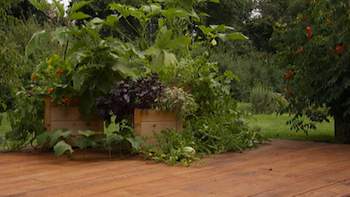By Sean Conway

At a recent family get-together, a nephew asked me for advice about starting a garden. He recently moved into an apartment with access to a rooftop patio, and that's where he wants to put the garden. But he wasn't sure where to begin.
A rooftop can be a challenging environment to garden in, but it can also yield excellent results. Planting vegetables in wooden boxes is a practical way to bring life to a rooftop deck while also providing food for the table. Moreover, keeping your garden contained makes it easier to care for, not to mention to set up.
To ensure success in any deck or rooftop garden, remember that these surfaces get very hot in the summer. Choose plants and planters that take this into account.
For my nephew I recommended starting with vegetables such as peppers, tomatoes, basil, eggplant and melons. These plants all grow well in the heat, provided they have ample moisture and that their roots don't overheat.
To help keep roots from over heating, choose a container that is light in color or one that will not absorb the sun's rays, such as wood. Also opt for a container that holds a large volume of soil. This will help to hold moisture and keep root temperatures moderate.
Most vegetables will grow well in planters. On a cool, partly shady deck, cool season vegetables such as lettuce or spinach are your best bet. To extend your container gardening season, try planting spring greens and then transition to hot weather crops as the growing season progresses.
If you choose wooden planters, they should be made of rot-resistant wood and should be set on blocks so that draining water won't affect the surface below them. For the non-do-it-yourselfer, these boxes (often made of cedar) can be purchased at a local garden store. Make sure there is a way for the excess water to drain out of the box and away from the deck. Staple ordinary window screening over drainage holes in bottom of planter to prevent erosion of the potting soil.
Planting a variety of vegetables will provide different leaf textures in deck planters, similar to those of a flower garden. Adding a trellis can provide even more options. A simple way to do that is to use heavy wire cattle fencing. Using bolt cutters, snip the fencing to the width of the planter and to the height desired. Attach trellis/fencing to the planter with 1/2-inch poultry staples.
Vines such as pole beans, cucumbers and even tomatoes can be trained up the trellis, thus freeing up space in your planter for other plants. For vines such as sweet potatoes or melons, place these plants at the front edge of your planter and allow them to grow out of the container and onto the deck. This will also free up space in the container. The plants will happily scramble along the deck, adding color and interest.
© Cultivating Life by Sean Conway
AUTOS | HOBBIES | EDUCATION | FAMILY | FASHION | FOOD & RECIPES | HOME DECOR | RELATIONSHIPS | PARENTING | PETS | TRAVEL | WOMEN
Home & Garden - Deck Patio Rooftop Garden Ideas